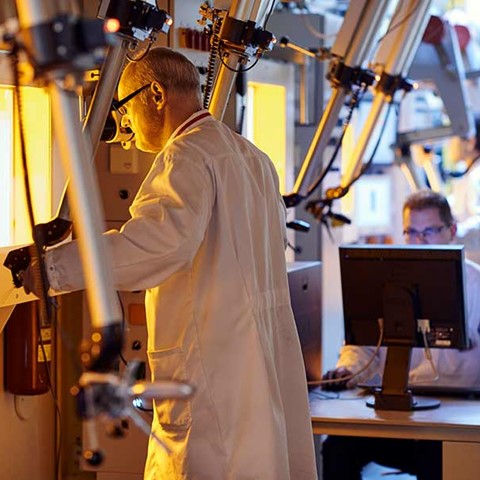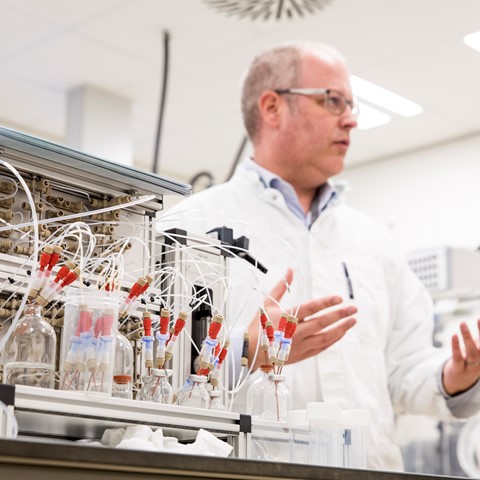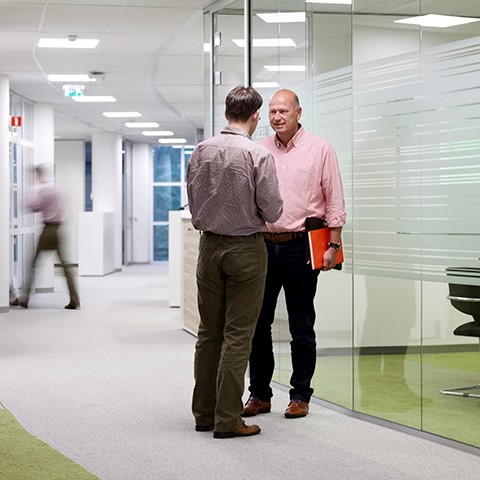High enriched uranium to low enriched uranium
From HEU to LEU medical isotopes
29 July 2020
Only low enriched uranium (LEU) is now used for the production of molybdenum
The first in Europe that stopped using High Enriched Uranium (HEU)
Successful permit change
New process, the same high standard
From HEU to LEU medical isotopes!
At the 2014 Nuclear Summit, commitments that were done earlier to phase out high enriched uranium (HEU) based medical isotopes and to only use low enriched uranium (LEU), were once again confirmed. This was an important issue because HEU can be used to produce nuclear weapons.
The facilities used at the Petten premises are the first in Europe to stop using HEU for production of molybdenum-99 (Mo-99), an important medical isotope that is commonly used worldwide. In order to achieve this great step forward, a long and complex road had to be followed.


Molybdenum-99
An important medical isotope for diagnostic purposes is Mo-99. This is the parent isotope of technetium-99m (Tc-99m), which is commonly used all over the world for a broad range of imaging in serious medical conditions. In order to only produce LEU based Mo-99, the whole supply chain for the production of Mo-99 had to be redesigned and qualified. When the first step of the supply chain of Mo-99 is changed, it may affect the subsequent steps in the processing of physical products and all necessary links in the supply chain. Just think of essential safety precautions, the design of a waste route, and the essential documents flow surrounding the production process of any (medical) radioisotope.
Therefore the HEU to LEU conversion in the whole supply chain is not a simple task. In total, NRG and Curium worked on it for more than 7 years, but in January 2018 the conversion to LEU was a fact.
Testing LEU based Mo-99
Curium produces Mo-99 from LEU targets irradiated in the reactor at the unique premises in Petten. NRG had the responsibility that the irradiation process was done to the same high standard and safety regulations in the High Flux Reactor. Curium was responsible for processing the irradiated material correctly at all times. Since LEU behaves differently from HEU, the newly designed process had to be tested intensively to ensure the same high quality and reliability of the LEU based material.
Permit change
Another crucial component of this project was the permit change from HEU to LEU based material. Aiming at a swift approval, we had to show and prove that we knew exactly how LEU behaved and affected the end product. After extensive R&D activities in various phases, the permit change was successfully achieved.
Another crucial element in this project was the license change of the Molybdenum Production Facility. Low enriched uranium (LEU) behaves differently from high enriched uranium (HEU) and this affects the chemical processes to achieve the same high-quality end product. After extensive R&D activities and safety studies in various phases, the permit amendment was approved by the Authority for Nuclear Safety and Radiation Protection (ANVS).

Waste treatment
The change to LEU as a starting material for Mo-99 production required the design and development of an adapted waste management route: an integral and essential part of the production of any radioisotope!
Competences, built up over decades of experience in handling nuclear materials and waste, enabled NRG and Curium to organize waste processing in such a way that it is also suitable for LEU. A new transport container has been specially developed for the transport of highly radioactive waste. And of course, we closely involved COVRA in the project and took their wishes into account.
Success
After years of extensive research, testing, development, and great cooperation, all the necessary installations, devices and permits were in order. This is a typical example of how the combining of complementary competences and experiences of our partners creates great solutions and leads to successful projects to advance nuclear medicine. In this case the first integrated supply chain of LEU based medical isotopes in Europe has been created and operationalised. A fact to be extremely proud of!
More information?

Contact us
Marjolijn Droog
Business manager Isotopes
T. +31 651 91 42 49
M. droog@nrg.eu
